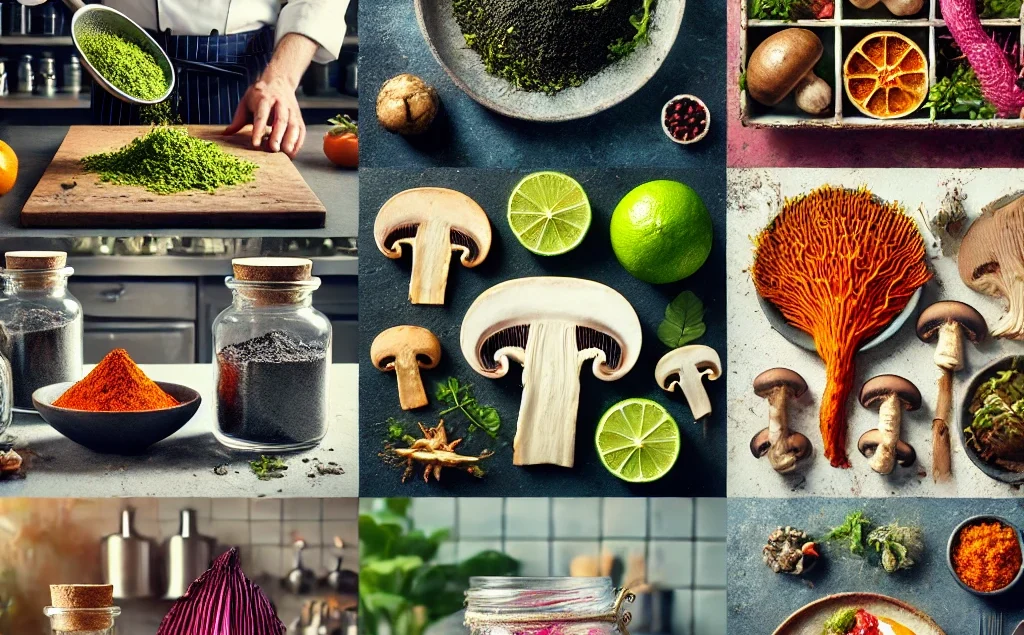No products in the cart.

Food Trends 2025: Black Lime, Mushrooms, Ashwagandha, and Kimchi
As we step into 2025, the global culinary landscape is experiencing an exciting transformation, and UAE kitchens are at the forefront of this evolution. Chefs in the UAE are seamlessly blending international flavors with local traditions, making the country a vibrant culinary hub. Among the many developments, four ingredients—black lime, kimchi, ashwagandha, and mushrooms—stand out as defining the food trends of 2025. These ingredients not only reflect global shifts toward health and sustainability but also showcase innovative approaches that resonate with modern diners.
The UAE’s Role in Shaping Food Trends 2025
The UAE has always been a melting pot of culinary ideas, pulling influences from around the world while staying true to its rich cultural heritage. As the country continues to grow as a global dining destination, it’s uniquely positioned to set food trends for 2025. From bold regional flavors to a renewed emphasis on health and sustainability, these trends are shaping what and how we eat.
Let’s explore how these four standout ingredients—black lime, kimchi, ashwagandha, and mushrooms—are redefining culinary experiences and becoming central to the food trends of 2025.
Black Lime: A Tangy Staple Reinvented
Black lime, or “loomi,” has been a cornerstone of Gulf cuisine for centuries, lending its tangy, smoky flavor to stews and marinades. In 2025, this traditional ingredient is experiencing a revival, as chefs across the UAE experiment with its versatile flavor profile in modern recipes.
Iman Nazemi, chef-owner of the Afghan restaurant Kishmish in Dubai, highlights black lime’s distinctive aroma and high vitamin C content. “Black lime is not only flavorful but also packed with antioxidants,” Nazemi explains. These characteristics align with the growing demand for functional and nutritious ingredients, making black lime a perfect fit for contemporary culinary trends.
Chefs are finding innovative ways to use black lime. Beyond traditional stews, they’re incorporating it into spice rubs for meats, infusing syrups for beverages, and even creating unique desserts. “The process of curing and drying limes with salt produces an intense flavor that’s both unique and versatile,” says Michael Collantes, consulting chef at Kaimana Beach in Jumeirah. This reinvention of black lime ties into the global movement toward celebrating local ingredients and sustainable practices.
Kimchi: The Fermentation Phenomenon
The global fermentation trend is here to stay, and kimchi is leading the charge in food trends for 2025. Traditionally a Korean staple made by fermenting Napa cabbage and radishes, kimchi is finding its way into diverse cuisines and applications. From burgers to fried rice, its umami-rich complexity is captivating chefs and diners alike.
Kelvin Cheung, chef at Jun’s, emphasizes kimchi’s multifaceted appeal. “Kimchi’s flavor complexity, sustainability, and wellness benefits make it a standout ingredient,” he says. Cheung has been experimenting with fermentation techniques, creating unique variations like miso kombucha and vinegar-infused kimchi.
Kimchi’s naturally probiotic-rich profile supports gut health and boosts immunity, aligning perfectly with the increasing consumer focus on wellness. Additionally, its zero-waste production method—which transforms vegetable scraps into long-lasting preserved ingredients—addresses critical sustainability concerns. Chefs in the UAE are also localizing kimchi by incorporating regional ingredients like beetroot or blending it into dishes such as hummus.
“Kimchi is more than a condiment; it’s an umami bomb that elevates any dish,” Cheung explains. This versatility ensures kimchi’s place at the forefront of 2025’s culinary trends.
Ashwagandha: The Adaptogenic Marvel
Ashwagandha, a key component of Ayurvedic medicine, is making its way from wellness shelves to fine dining tables. Known for its adaptogenic properties, ashwagandha helps reduce stress, boost immunity, and promote overall well-being. In 2025, this earthy, bitter herb is set to become a culinary favorite as chefs explore its potential in innovative recipes.
Chef Rahul Raha of Avatara, a Michelin-starred vegan restaurant, champions ashwagandha for its health benefits and versatility. Typically used in powder form, ashwagandha can be mixed with ghee, honey, or water to create nutritious recipes. Many chefs are also incorporating it into desserts, balancing its earthy notes with sweetness.
“The intersection of health and gastronomy is driving interest in adaptogenic herbs like ashwagandha,” says Hala Ayash, a consulting chef and television presenter. As diners seek both nourishment and innovation, ashwagandha’s rising popularity reflects this demand. Its inclusion in the food trends for 2025 highlights the growing emphasis on functional ingredients that offer more than just flavor.
Mushrooms: The Food of the Future
Once a supporting ingredient, mushrooms are taking center stage in 2025 as chefs unlock their full potential. From hearty mushroom steaks to creamy pates and smoky terrines, these fungi are proving their ability to rival traditional meat dishes in both flavor and texture.
“Mushrooms are here to stay,” says Gabriella Chamorro, chef at Girl and the Goose. “They’re sustainable, versatile, and packed with nutrients, making them the food of the future.” Chefs are exploring rare varieties like lion’s mane and trumpet mushrooms, which add unique flavors and textures to dishes.
Mushrooms’ sustainability is another reason for their rise in popularity. Growing mushrooms requires fewer resources than many other crops, aligning with the UAE’s sustainable agriculture goals. Beyond savory dishes, mushrooms are also finding their way into beverages, such as mushroom-infused coffee and teas, further showcasing their versatility.
Why These Ingredients Define Food Trends 2025
The rise of black lime, kimchi, ashwagandha, and mushrooms reflects broader shifts in global dining preferences. These ingredients align with key trends, including:
- Health and Wellness: Consumers are increasingly prioritizing foods that offer both flavor and health benefits. Ingredients like ashwagandha and kimchi cater to this demand by supporting immunity and gut health.
- Sustainability: Sustainability is a driving force behind modern culinary innovations. Black lime’s use of traditional preservation methods and mushrooms’ low environmental impact are prime examples of this trend.
- Bold Flavors and Regional Influences: The emphasis on bold, regional flavors is evident in the use of black lime and localized kimchi variations. These ingredients celebrate cultural heritage while offering new culinary experiences.
- Innovation in Cooking Techniques: Chefs are experimenting with fermentation, drying, and other techniques to reinvent traditional ingredients. This innovation keeps dining experiences exciting and relevant.
The Future of Dining in 2025
As the UAE continues to solidify its status as a global culinary hub, its chefs are uniquely positioned to shape food trends for 2025. By embracing ingredients like black lime, kimchi, ashwagandha, and mushrooms, they are redefining how we think about flavor, nutrition, and sustainability.
These trends not only reflect the UAE’s rich culinary heritage but also highlight its commitment to innovation and global relevance. As diners become more health-conscious and sustainability-focused, these four ingredients will undoubtedly play a significant role in shaping the future of dining.
Whether it’s the tangy depth of black lime, the probiotic richness of kimchi, the adaptogenic benefits of ashwagandha, or the umami-packed versatility of mushrooms, the food trends for 2025 promise a year of exciting culinary discoveries.


